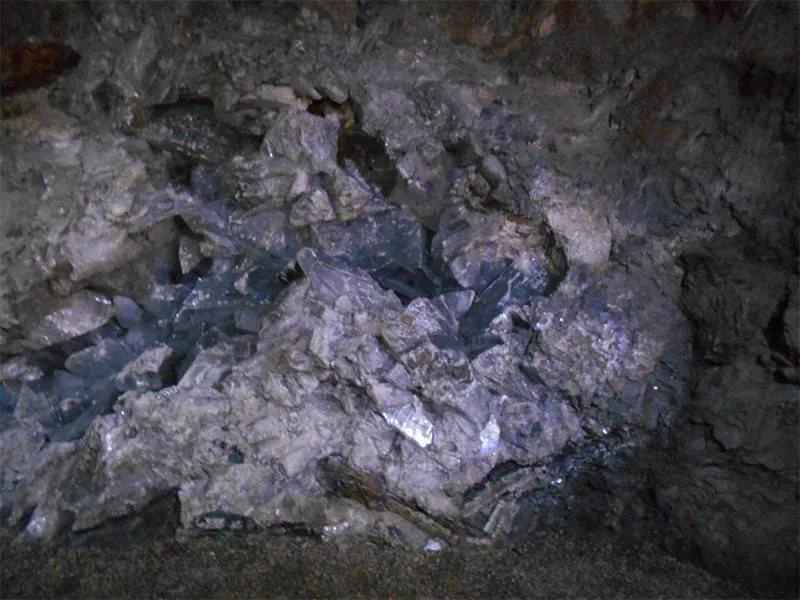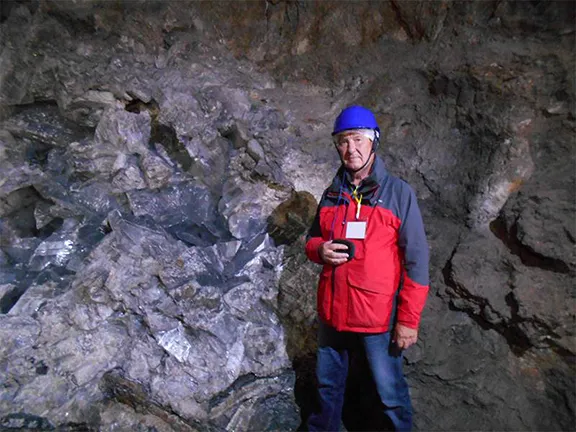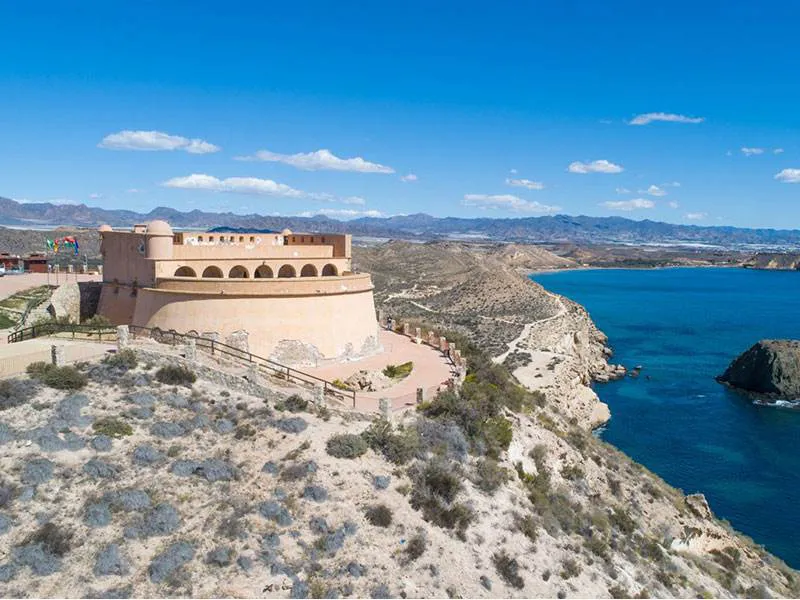The Pulpi geode or Giant geode, is the largest geode in Europe, the second largest in the world and the largest geode in the world accessible to the public.
By Nick Nutter | Updated 25 May 2022 | Almería | Places To Go |
Login to add to YOUR Favourites or Read Later


Julie outside the Pulpi geode
In the far northeast of Andalucia, within 1 kilometre of the border with Murcia, is a small town with hidden attractions that would have remained virtually unknown if not for a remarkable discovery in 1999. The largest geode in Europe was uncovered in Mina Rica, an iron and lead mine near the town of Pulpi. Mina Rica was opened to the public in August 2019.


Large gypsum crystals
On Tuesday 15th February 2022, the giant geode of Pulpí was declared a Natural Monument of Andalucia. The declaration includes the geode and the mine that contains it, an area of about 10 hectares. “This cataloging represents a recognition of its environmental value and its uniqueness, at the same time that it will allow to improve the effectiveness and efficiency of the management of the space and guarantee its conservation”, explained the Andalusian councilor, Carmen Crespo.


Mina Rica near Pulpi
A geode is a cavity in rock that contains crystals. You will have seen small examples for sale in tourist shops, hollow rocks, split open to reveal amethyst or quartz crystals within. Unlike those examples that will fit into a display cabinet, the geode at Pulpi is 8 metres long and nearly 2 metres in diameter. The gypsum crystals within are up to 2 metres long yet still leave room in the cavity for up to 10 people. The only geode in the world that is larger is in Mexico but that one is not accessible to the public, whilst the Pulpi geode is. Only the original discoverers, a few scientists and a group of promotional photographers have had the privilege of entering the geode. Gypsum is a mineral called calcium sulphate dihydrate and it is very soft, number 2 on the Mohs scale (talc is the softest at number 1, diamond is the hardest at 10). The crystals are easily damaged so are now viewed through an aperture in the rock. Scientists have calculated that the geode formed over a period of 2 million years ending about 60,000 years ago.


Gypsum crystals in Mina Rica
Guided tours last approximately 90 minutes and start at an information office at Mina Rica. You are advised to arrive 30 minutes before your tour is scheduled to start. There is lots of free parking.


Castle at San Juan de los Terreros
Tour guides speak Spanish so, when you hand in your prepaid ticket, mention that you would like an English tablet. The first four episodes on the tablet inform you of the history of the mine. You should listen to these as you are walking to the mine entrance.


Pulpi geode
During the visit within the mine you have to negotiate a metal spiral staircase with about 80 steps to reach the level at which the geode formed. The guide is good enough to tell the group that the descent is not for those who suffer from vertigo, claustrophobia, or any heart or lung complaint, but only after you have spent an hour reaching that point.
Notes:
The big spiral staircase with 168 steps is only an emergency exit. You will not be going up or down that one
There is talk of them putting a lift in but at the moment (January 2020) it is just talk.
How wrong can I be. In April 2020, Mina Rica was closed whilst an elevator was installed. It re-opened in June 2020.
Included in the entrance fee to see the geode is the entrance fee to the Castillo de los Terreros which is six kilometres from the mine in the seaside resort of San Juan de los Terreros. Within the castle is a room in which you can experience a virtual tour of Mina Rica. The virtual tour costs 1 Euro per person. It is well worth the trip and the fee. It can only be described as an incredible sensation. The virtual tour closes inside the geode.
The Pulpi geode has been extensively researched since its discovery and a paper, produced in 2019, and printed in National Geographic, reveals how and when the geode formed.
“There is no one way to form a geode,” says Gabriela Farfan, an environmental mineralogist at the Smithsonian National Museum of Natural History who wasn’t involved with the study. For many geodes, though, the basic science is somewhat similar.
A rock cavity is formed when magma containing gas bubbles cools, when cracks are created by tectonic activity, and so on. The cavity is infiltrated with hydrothermal fluids. Once inside, their dissolved elements can crystallize out on the walls. Stable temperatures, plenty of ingredients, and lots of time tend to result in larger crystals.
Gypsum is a chemical compound containing calcium sulfate, along with multiple molecules of water. Then you have gypsum anhydrite, which is calcium sulfate without the water. Below 136 degrees Fahrenheit, gypsum is the more stable compound, and anhydrite will effortlessly dissolve in water, creating the building blocks for gypsum. When the water is lost, gypsum will crystallize out.
"Gypsum, though, has a particular aptitude for forming especially colossal crystals", says Mike Rogerson, an Earth systems scientist at the University of Hull who wasn’t part of the work. Gypsum’s crystal makeup can accommodate a lot of water, producing plenty of volume using a relatively small mass of anhydrite.
Researchers found that Pulpí’s gypsum anhydrite was laid down around 250 million years ago, during the Triassic period, when the Pangaea supercontinent existed and the rise of the dinosaurs had begun. The timing of the gypsum growth is harder to pin down, because the crystals contain few datable impurities, but a radiometrically dated carbonate cap above the crystals means that they formed no later than 60,000 years ago. Based on the timing of the tectonic deformation at the site, they started growing no earlier than two million years ago.
High-temperature minerals such as barite and celestine appeared first. But the hot hydrothermal system eventually waned. Temperatures dropped below the critical 136-degree threshold and eventually settled out at 68 degrees for a long time producing the perfect conditions that allowed the gypsum to crystallize out en masse.
A strange chemical quirk known as Ostwald ripening is also thought to be partly to blame for their large size. In this broiling chemical soup, smaller gypsum crystals dissolve back into the mix, where their ingredients were then cannibalized onto the larger crystals, boosting their growth.
At the same time, the subterranean environment experienced temperature oscillations over geological timescales, just inching above and below 68 degrees. During slightly warmer times, those smaller crystals dissolve more easily. During somewhat chillier times, the larger crystals get to grow more. "The overall effect of this", García-Ruiz says, "is to amplify the ripening process."
As to what caused such tiny temperature fluctuations over such lengthy timescales, the team points the finger at the planet’s natural warming and cooling cycles, driven by wobbles in Earth’s circumnavigation of the sun.
The mine was opened to the public in August 2019. It is proving hugely popular with tours booked weeks in advance.
You must book your tickets on line here.